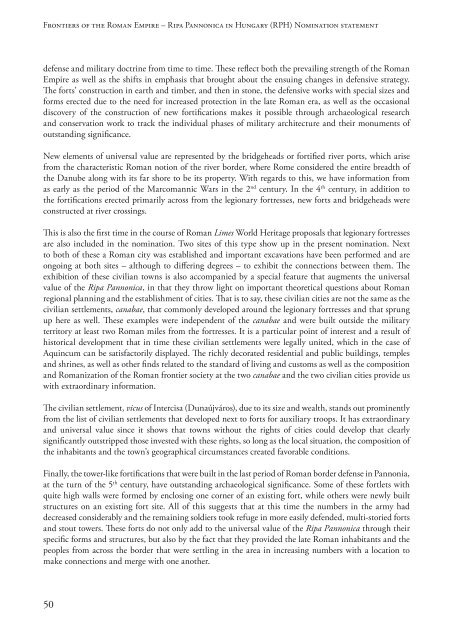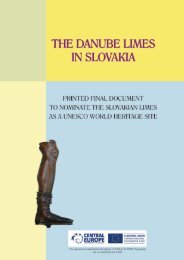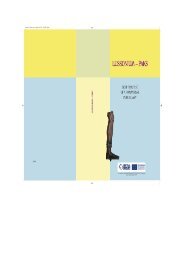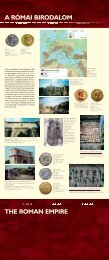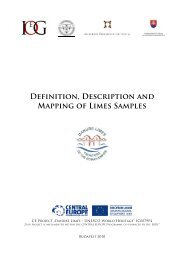the PDF version! - Danube Limes
the PDF version! - Danube Limes
the PDF version! - Danube Limes
Create successful ePaper yourself
Turn your PDF publications into a flip-book with our unique Google optimized e-Paper software.
Frontiers of <strong>the</strong> Roman Empire – Ripa Pannonica in Hungary (RPH) Nomination statement<br />
defense and military doctrine from time to time. These reflect both <strong>the</strong> prevailing strength of <strong>the</strong> Roman<br />
Empire as well as <strong>the</strong> shifts in emphasis that brought about <strong>the</strong> ensuing changes in defensive strategy.<br />
The forts’ construction in earth and timber, and <strong>the</strong>n in stone, <strong>the</strong> defensive works with special sizes and<br />
forms erected due to <strong>the</strong> need for increased protection in <strong>the</strong> late Roman era, as well as <strong>the</strong> occasional<br />
discovery of <strong>the</strong> construction of new fortifications makes it possible through archaeological research<br />
and conservation work to track <strong>the</strong> individual phases of military architecture and <strong>the</strong>ir monuments of<br />
outstanding significance.<br />
New elements of universal value are represented by <strong>the</strong> bridgeheads or fortified river ports, which arise<br />
from <strong>the</strong> characteristic Roman notion of <strong>the</strong> river border, where Rome considered <strong>the</strong> entire breadth of<br />
<strong>the</strong> <strong>Danube</strong> along with its far shore to be its property. With regards to this, we have information from<br />
as early as <strong>the</strong> period of <strong>the</strong> Marcomannic Wars in <strong>the</strong> 2 nd century. In <strong>the</strong> 4 th century, in addition to<br />
<strong>the</strong> fortifications erected primarily across from <strong>the</strong> legionary fortresses, new forts and bridgeheads were<br />
constructed at river crossings.<br />
This is also <strong>the</strong> first time in <strong>the</strong> course of Roman <strong>Limes</strong> World Heritage proposals that legionary fortresses<br />
are also included in <strong>the</strong> nomination. Two sites of this type show up in <strong>the</strong> present nomination. Next<br />
to both of <strong>the</strong>se a Roman city was established and important excavations have been performed and are<br />
ongoing at both sites – although to differing degrees – to exhibit <strong>the</strong> connections between <strong>the</strong>m. The<br />
exhibition of <strong>the</strong>se civilian towns is also accompanied by a special feature that augments <strong>the</strong> universal<br />
value of <strong>the</strong> Ripa Pannonica, in that <strong>the</strong>y throw light on important <strong>the</strong>oretical questions about Roman<br />
regional planning and <strong>the</strong> establishment of cities. That is to say, <strong>the</strong>se civilian cities are not <strong>the</strong> same as <strong>the</strong><br />
civilian settlements, canabae, that commonly developed around <strong>the</strong> legionary fortresses and that sprung<br />
up here as well. These examples were independent of <strong>the</strong> canabae and were built outside <strong>the</strong> military<br />
territory at least two Roman miles from <strong>the</strong> fortresses. It is a particular point of interest and a result of<br />
historical development that in time <strong>the</strong>se civilian settlements were legally united, which in <strong>the</strong> case of<br />
Aquincum can be satisfactorily displayed. The richly decorated residential and public buildings, temples<br />
and shrines, as well as o<strong>the</strong>r finds related to <strong>the</strong> standard of living and customs as well as <strong>the</strong> composition<br />
and Romanization of <strong>the</strong> Roman frontier society at <strong>the</strong> two canabae and <strong>the</strong> two civilian cities provide us<br />
with extraordinary information.<br />
The civilian settlement, vicus of Intercisa (Dunaújváros), due to its size and wealth, stands out prominently<br />
from <strong>the</strong> list of civilian settlements that developed next to forts for auxiliary troops. It has extraordinary<br />
and universal value since it shows that towns without <strong>the</strong> rights of cities could develop that clearly<br />
significantly outstripped those invested with <strong>the</strong>se rights, so long as <strong>the</strong> local situation, <strong>the</strong> composition of<br />
<strong>the</strong> inhabitants and <strong>the</strong> town’s geographical circumstances created favorable conditions.<br />
Finally, <strong>the</strong> tower-like fortifications that were built in <strong>the</strong> last period of Roman border defense in Pannonia,<br />
at <strong>the</strong> turn of <strong>the</strong> 5 th century, have outstanding archaeological significance. Some of <strong>the</strong>se fortlets with<br />
quite high walls were formed by enclosing one corner of an existing fort, while o<strong>the</strong>rs were newly built<br />
structures on an existing fort site. All of this suggests that at this time <strong>the</strong> numbers in <strong>the</strong> army had<br />
decreased considerably and <strong>the</strong> remaining soldiers took refuge in more easily defended, multi-storied forts<br />
and stout towers. These forts do not only add to <strong>the</strong> universal value of <strong>the</strong> Ripa Pannonica through <strong>the</strong>ir<br />
specific forms and structures, but also by <strong>the</strong> fact that <strong>the</strong>y provided <strong>the</strong> late Roman inhabitants and <strong>the</strong><br />
peoples from across <strong>the</strong> border that were settling in <strong>the</strong> area in increasing numbers with a location to<br />
make connections and merge with one ano<strong>the</strong>r.<br />
50


